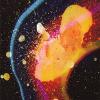That seems more or less correct to me. At some point you'll want to implement some sort of light culling so that you're not shading every pixel with every light. But yeah, typically you'll have one shader for every material type, and one shader for every light type (directional, point, ambient, etc.). In your first pass, you bind the G-buffer as your render target. You render the scene using the material shaders, which output normals, diffuse, etc., to their respective textures in the G-buffer. In the second stage, you go one light at a time, and you render a full-screen quad using the correct light shader for each light. The light shader samples from each of the G-buffer textures, and applies the correct lighting equations to get the final shading value for that light. Make sure to additively blend the light fragments at this stage.
What a lot of people do, in order to cut down on the number of pixels being shaded with a given light, is to have some geometric representation for the light (a sphere for a point light, for example). Before rendering the full-screen quad with the point light shader, they'll stencil the sphere in so that they can be sure to only shade pixels within that sphere. Some even go as far as to treat the sphere almost like a shadow volume, stenciling in only the portions where scene geometry intersects the sphere. This gives you near pixel-perfect accuracy, but it might be overkill. I've been reading lately that some people just approximate the range of the point light using a billboarded quad, because the overhead in rendering a sphere into the stencil buffer (let alone doing the shadow volume thing) is greater than the time spent unnecessarily shading pixels inside the quad that the light can't reach.
Of course, a real point light can reach anywhere. If you were to use a sphere to approximate the extent of the point light, you'd have to use a somewhat phony falloff function so that the light attenuates to zero at the edge of the sphere.






